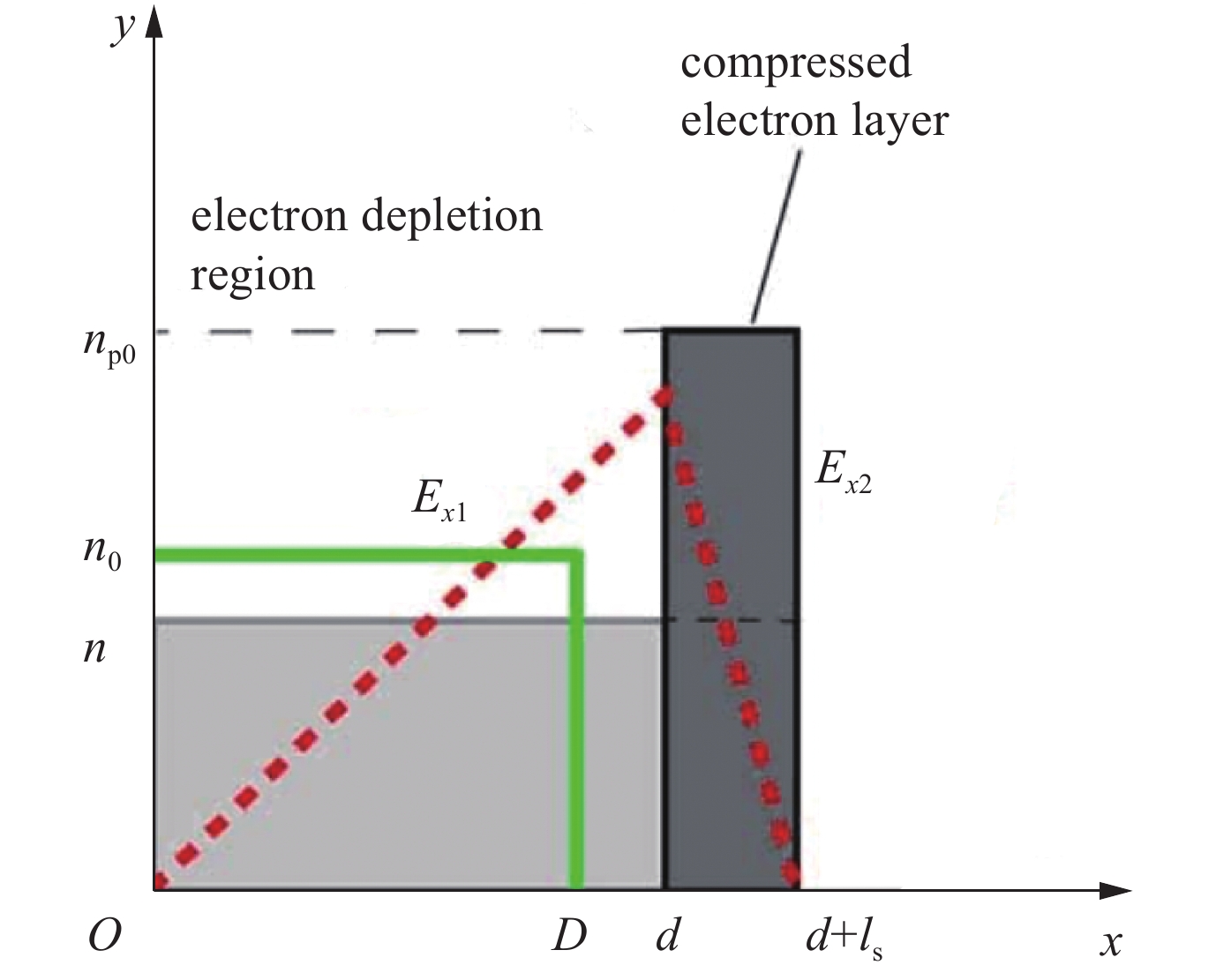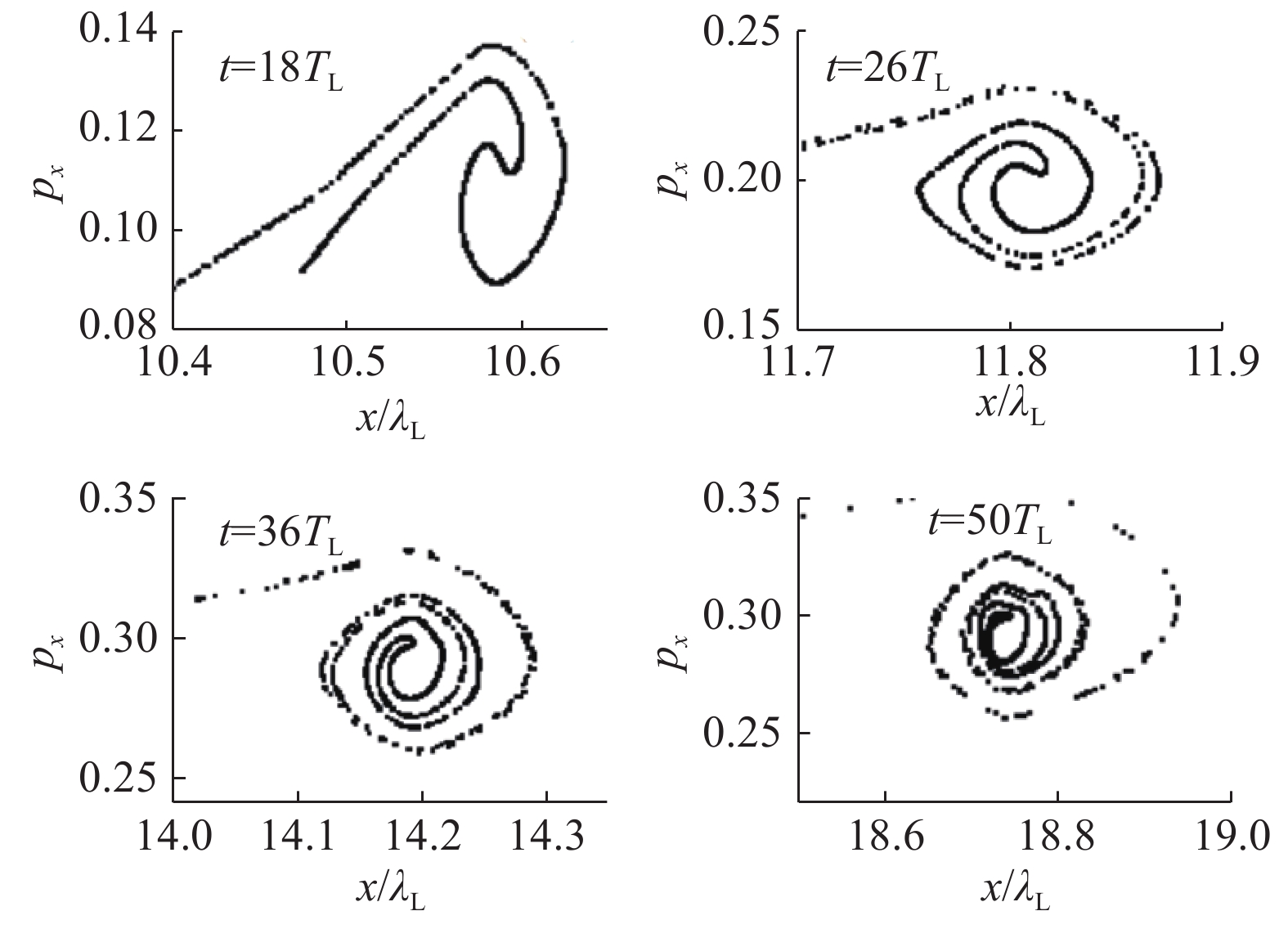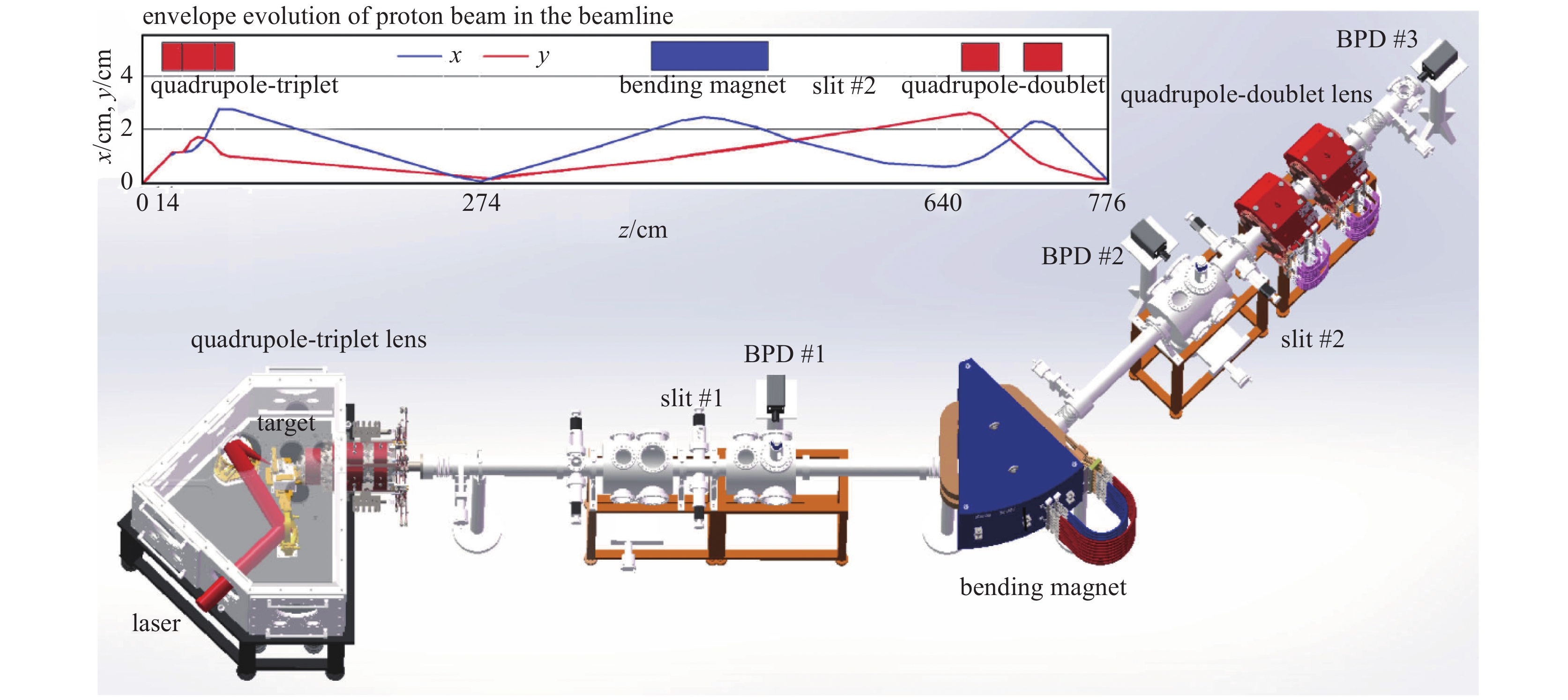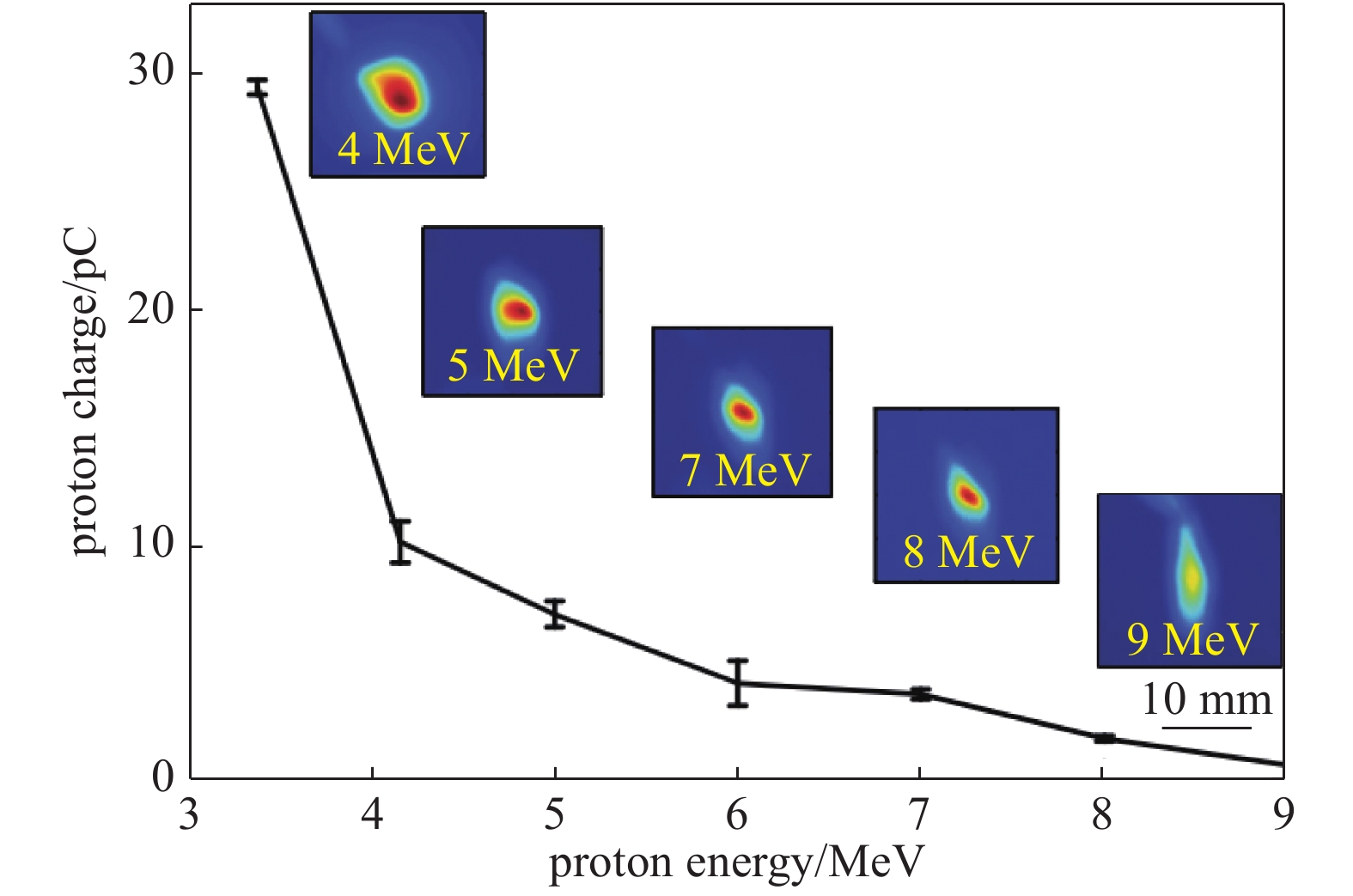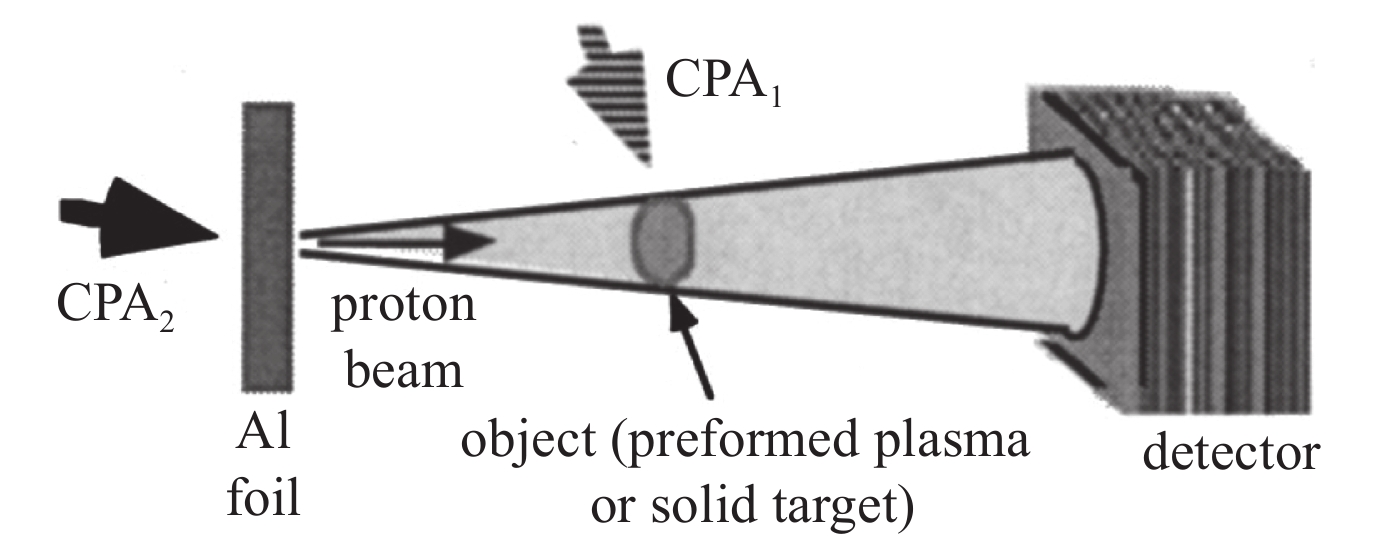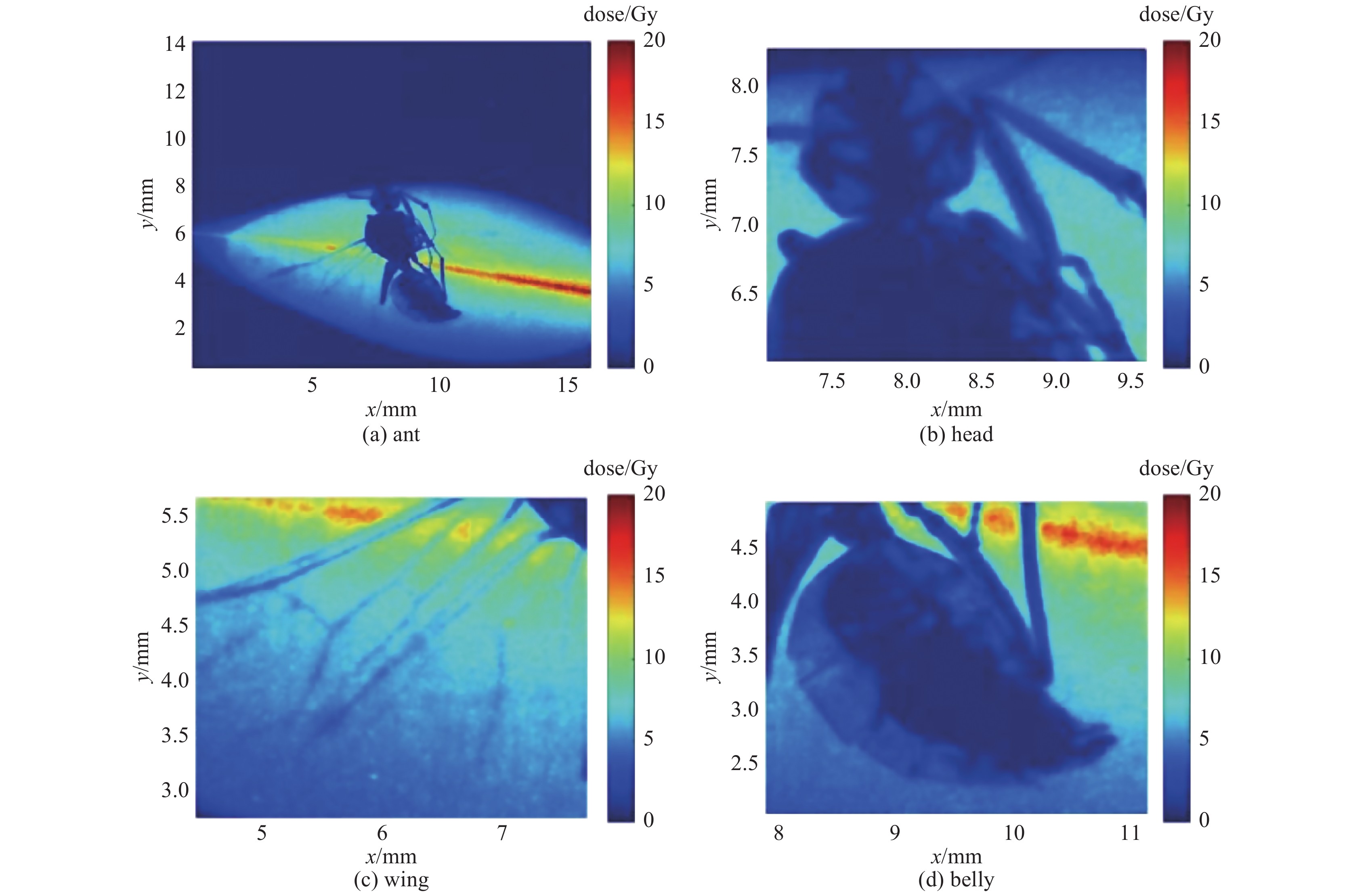Laser-driven ion acceleration: development and potential applications
-
摘要: 激光离子加速是近年来激光等离子体领域兴起的研究热点之一。激光产生的高能离子束具有高亮度、小尺寸、脉宽窄和方向性好等特点,具有很多潜在的应用。概述了几种常见的激光离子加速物理机制,对一系列激光离子加速实验进展进行了归纳总结,最后介绍了几种激光驱动离子束的潜在应用。Abstract: Laser-driven ion acceleration is a frontier of laser plasma physics which has been developed in recent decades. Energetic ion beam generated in the interaction of laser and matter has unique properties such as high brilliance, compact size, ultra-short duration, and low emittance. These advantages are particularly suitable for many potential applications. This paper describes the main physical mechanism of ion acceleration driven by ultrashort laser. It reviews the progress of a series of laser-driven ion acceleration experiments. At last, it provides a brief introduction of several potential applications of laser-driven ion sources.
-
Key words:
- laser plasma /
- particle accelerator /
- ultra-short laser /
- ultra-intense laser
-
放射性核素识别是核安全领域的关键问题之一,其旨在通过对探测器获取的放射性核素伽马能谱进行分析,获取放射性物质组成元素的种类与含量等信息。传统核素识别方法将能谱特征峰相关信息作为核素特征与标准核素库进行比对,以此判断核素的种类[1-3]。如何快速准确获得特征峰相关信息成为此类方法的关键,然而探测器噪声[4]、本底辐射[5]等会对寻峰及识别带来一定的影响,因此,传统的核素识别方法主要集中于寻峰方法的研究,常见的寻峰方法有导数法、对称零面积法等[6]。核素识别问题本质上是分类问题,提取何种特征才能有效地表征能谱是值得研究的问题。本文提出了一种基于稀疏表示[7]的核素能谱特征提取方法,将核素能谱作为“时间”序列看待,从序列结构着手,对能谱在稀疏字典上进行顺次分解,并将分解系数向量作为能谱特征。与经典稀疏分解方法不同,该方法在分解过程中对核素能谱按照稀疏字典中的原子排列顺序顺次进行分解;其次,核素识别要求不同核素在所提特征下的可区分性,提取到的特征(分解系数)对不同核素具有可区分性即可,并不要求核素能谱的重构精度,所以只选取若干最具区分性的特征表征核素能谱。
1. 核素能谱特征提取及其识别
1.1 伽马能谱稀疏分解
信号稀疏表示是一种通过较少的特定信息去尽可能准确地表示原始信号的方法。在稀疏表示方法中,信号可以用不同基信号的线性叠加表示,这些基信号的集合被称为字典,基信号又被称为原子。信号的稀疏表示是指在一个过完备字典库中,选择尽量少的原子表达原始信号,使得信号的表示更加简洁。
设待分解能谱信号为y,y为一个长度为M的列向量,过完备稀疏字典矩阵D=(x1, x2, …, xd),字典中的每个原子xi的长度都与信号y的长度M相同,即D为M×d的矩阵,且每个原子都由一个高斯函数构成,即
xi(t)=(s)−1/2⋅g[(t−u)/s]⋅cos(vt+w) (1) 式中:xi为字典矩阵D中的第i个原子;g为高斯函数;原子xi由参数(s, u, v, w)决定;s为尺度因子;u为位移因子;v为原子频率;w为原子相位。稀疏字典可以通过参数构造或者学习得到,本文采用参数字典。基于稀疏表示的核素能谱特征提取方法具体步骤如下:
(1) 核素能谱稀疏分解。按照稀疏字典D中原子顺序,计算信号y与字典矩阵中第一个原子的内积,即
ω1=⟨y,xr1⟩ (2) 式中: r1为第1个原子在字典中的列索引。信号y被分解为在xr1上的垂直投影分量和残差分量,即
y=⟨y,xr1⟩xr1+R1f (3) (2) 对残差信号逐次分解得到每个原子上的分解系数,第k+1次分解后的残差信号为
Rkf=⟨Rkf,xrk+1⟩xrk+1+Rk+1f (4) 经过k+1次分解后,能谱信号y被分解为:
y=k∑n=0⟨Rnf,xrn+1⟩xrn+1+Rk+1f (5) 其中,R0f=y,ωk+1=⟨Rnf,xrn+1⟩为第k+1次稀疏分解的系数,xrk+1为稀疏字典D第k+1个原子,Rk+1f为残差分量。
(3) 逐次进行上述分解过程,直到求得能谱信号在系数字典所有原子上的稀疏系数。
1.2 特征提取及核素识别
稀疏分解得到的系数向量(ω1, ω2, …, ωd)可以作为核素能谱的特征向量表征能谱,但是特征数目过多会给后续分类模型建立带来过大的计算量,有时过训练问题也会出现,所以需要对所得特征进行筛选。
设G表示筛选得到的原子集合,并初始化为G=Φ。对于每一个类别的核素能谱均不放回地随机抽取一个核素能谱y,按上述方法对其进行稀疏分解,并找到其稀疏分解最大系数(考虑到稀疏分解系数有可能为负,这里的最大系数指绝对值最大)所对应的原子x,即
|⟨y,x⟩|=maxi∈{1,2,⋯,d}{|⟨y,xi⟩|} (6) 将最大系数对应的原子x按照式(7)所示方式并入原子集合G,
G={G∪{x}, if x∉GG, otherwise (7) 重复上述过程,直到|G|=Ngs,Ngs为事先设定的阈值。将G中的原子按照其在稀疏字典D中的顺序进行排序。对于任意一个核素能谱y,其系数向量记为
t=(t1,t1,⋯,tNgs) (8) 式中:ti为能谱y在G中第i个原子上的系数,这里认为G中原子顺序已定。
图 1为137Cs,60Co,152Eu各随机选取一个能谱进行稀疏分解提取到的系数向量图,从图中可以看出,根据上述方法提取到的核素特征对三个不同种类的核素能谱具有较好的区分能力。
为了利用模式识别算法进行核素识别,将该核素的类别信息加入特征向量t,即t=(t1, t1, …, tNgs, c), 其中c表示该核素类别。多个核素能谱(多个类别)的特征向量集,即模式识别算法的训练样本集可表示为X,X={ti}={(t1it2i, …, tNgsi, ci)},i=1, 2, …, N,其中N为能谱个数。利用训练样本集,通过模式识别算法可得到核素分类模型,利用此分类模型即可进行未知类别核素能谱的识别。
2. 实验结果与分析
2.1 实测能谱核素识别实验
为了验证所提方法的有效性,对比了基于稀疏表示的特征提取方法与两种传统核素特征提取方法的分类准确率,这两种传统方法分别是:Savitzky-Golay(SG)平滑结合导数寻峰的方法和梯形窗平滑(TS)结合导数寻峰的方法。实验数据采用241Am, 133Ba, 60Co, 137Cs, 131I和152Eu共6种核素1200个核素能谱数据,分别在7个模式识别分类算法上进行了对比实验,这7种模式识别分类方法分别是:最近邻分类算法[8](KNN)、朴素贝叶斯分类算法[9](NavieBayes)、支持向量机算法[10](SMO), PART Decision List算法[11](PART), C4.5决策树分类算法[12](C4.5), CART决策树分类算法[13](CART)和RBF神经网络算法[14](RBFNetwork)。实验采用十折交叉验证法进行,即将6种核素1200个核素能谱数据均匀划分为10份,其中9份作为训练数据,另外1份作为测试数据,依次循环10次,分类准确率为10次实验的平均值。
表 1给出了三种不同特征提取方法所提特征在不同分类方法上的分类结果。可以看到,基于稀疏表示的特征提取方法的识别率普遍高于90%,分类效果较好;而两种传统的特征提取方法识别率均较低,在SMO方法上甚至低至20%以下。可以认为基于稀疏表示的特征提取方法能够有效地提取到区分能力更强的能谱特征,其原因在于该方法选择区分能力最好的稀疏原子分解系数作为能谱特征。
表 1 三种特征提取方法在模拟核素上的识别结果Table 1. Classification results of the three feature extraction methodsmethods sparse representation(rank) SG +derivative(rank) TS+derivative(rank) KNN 97.11%(1) 88.75% (2) 72.67% (3) NavieBayes 88.57%(1) 44.58% (2) 38.92% (3) SMO 72.86%(1) 19.50% (3) 21.83% (2) PART 96.00%(1) 91.25% (2) 78.00% (3) J48 96.86%(1) 90.83% (2) 74.42% (3) CART 96.29%(1) 89.50% (2) 76.00% (3) RBFNetwork 94.29%(1) 73.17% (2) 58.00% (3) mean 91.71%(1) 71.08%(2.14) 59.98%(2.86) 2.2 实验结果统计分析
Demsar[15]结合统计学原理,针对多个分类器在多个数据集上的分类结果比较问题,提出了一种统计分析比较的方法。该方法利用Friedman test和Holm test检验各个分类器的分类结果之间是否存在明显差异。在本实验中,首先利用Friedman test方法检验各个特征提取方法之下的分类结果是否存在明显差异。若存在明显差异,再利用Holm test方法具体比较基于稀疏表示的特征提取方法和另外两种特征提取方法的分类结果之间是否存在明显差异。
不同的特征提取方法在各个分类器下的分类结果不尽相同,Friedman test将这些分类准确率进行排序,对任意一个分类器而言,每种特征提取方法在其上的分类结果将被排序,每种特征提取方法都会得到唯一的一个序数值,如表 1所示。假设共有N个分类器、k种不同的特征提取算法,每一种特征提取算法在每个分类器下都进行了分类实验。首先用rij表示第i种分类器在第j种特征提取方法下的序数值。再计算每一种特征提取方法的均序Rj,Rj=1N∑jrji。Friedman test假设所有k种特征提取方法下的核素分类结果相同,Friedman统计量表达式为
χ2F=12Nk(k+1)(∑jR2j−k(k+1)24) (9) 该统计量服从卡方分布,其自由度为k=1。
在本实验中,N=7,k=3,χF2=12.31,该结果表明在α=0.05时(即显著性水平为0.05),3种特征提取方法下的核素分类结果相同的假设被拒绝,即本实验考虑的3种特征提取方法的分类结果具有明显的差异。
利用Holm test方法来检验基于稀疏表示的特征提取方法分类结果和另外2种特征提取方法的分类结果之间是否存在明显的差异。比较两个分类器的统计量为
z=R1−R2√k(k+1)6N (10) Holm test具体过程如下:根据z值在标准正态分布表中找到对应的概率p,按从小到大的顺序对多次两两比较中得到的p进行排列,记为p1, p2, …, pk-1。Holm test将对pi和α/(k-i)的大小进行比较,如果α/(k-i)大于或等于pi,则拒绝原假设(原假设为:pi对应的两个分类器具有相同的分类效果)。
本实验中,从表 1可以得到,R1=1,R2=2.14,R3=2.86,R1为基于稀疏表示的特征提取方法的均序值,R2和R3分别代表SG平滑+导数寻峰的均序值和梯形平滑+导数寻峰的均序值。在显著性水平为α=0.05的情况下,由k=3及N=7可以计算得到标准误差SE=√k(k+1)6N=√3×46×7=0.5354。Holm test的具体结果如表 2所示。
表 2 Holm检验Table 2. Holm testi methods z=(Ri-R1)/SE p α/(k-i) 1 TS+derivative peak seeking (2.86-1)/0.535 4=3.479 7 0.000 5 0.025 0 2 SG+derivative peak seeking (2.14-1)/0.535 4=2.132 7 0.032 9 0.050 0 Holm test排除了两个原假设,即在显著性水平为α=0.05的情况下,基于稀疏表示的特征提取方法的分类结果与SG+导数寻峰和梯形平滑+导数寻峰特征提取方法的分类结果之间存在显著差异,而从表 1可以看到,前者的分类准确率明显高于后两者的分类准确率,可以认为,所提方法的分类准确率显著地高于上述两种方法的分类准确率。
3. 结论
基于稀疏表示的特征提取方法将核素能谱视作时间序列,从整体上分析其结构特征,利用稀疏分解方法提取能谱特征,避免了谱光滑、寻峰等操作。在6种核素共1200个核素能谱上的识别实验结果表明该方法所提特征对不同核素具有可区分性,实验结果的统计分析表明对于核素识别而言,该特征提取方法显著地优于导数寻峰法,所提特征能够更好地表征核素能谱的结构特性。如果核素能谱数据中既包含强噪声背景下的核素能谱,又包含弱噪声背景下的同一种核素能谱,此方法的识别效果就会有一定的下降,此时可以先对能谱数据进行去噪,在以后的工作中,将针对此问题进行研究。
-
表 1 激光离子加速实验结果(2000—2019)
Table 1. Results of laser-driven ion acceleration experiments(2000—2019)
reference pulse energy
WL/Jirradiance I0/
(W/cm2)contrast target incidence
angle/(°)proton/ion energy ε(p/i)/(MeV/nucleon) Snavely et al(2000) 423 3×1020 1×104 CH 100 μm 0 58 Krushelnick et al(2000) 50 5×1019 Al 125 μm 45 30 Nemoto et al(2001) 4 6×1018 5×105 Mylar 6 μm 45 10 Mackinnon et al(2002) 10 1×1020 Al 3 μm 22 24 Patel et al(2003) 10 5×1018 1×1010 Al 20 μm 0 12 Spencer et al(2003) 0.2 7×1018 Mylar 23 μm 0 1.5 Spencer et al(2003) 0.2 7×1018 1×106 Al 12 μm 0 0.9 McKenna et al(2004) 233 2×1020 1×106 Fe 100 μm 45 40 Kaluza et al(2004) 0.85 1.3×1019 1×107 Al 20 μm 30 4 Oishi et al(2005) 0.12 6×1018 2×107 Cu 5 μm 45 1.3 Fuchs et al(2006) 10 6×1019 1×105 Al 20 μm 0,40 20 Neely et al(2006) 0.3 1×1019 1×107 Al 0.1 μm 30 4 Willingale et al(2006) 340 6×1020 1×1010 He jet 2000 μm 10 Ceccotti et al(2007) 0.65 5×1018 1×105 Mylar 0.1 μm 45 5.25 Robson et al(2007) 310 6×1020 1×1010 Al 10 μm 45 55 Robson et al(2007) 160 3.2×1020 1×107 Al 10 μm 45 38 Robson et al(2007) 30 6×1019 1×107 Al 10 μm 45 16 Antici et al(2007) 1 1×1018 1×107 Si3N4 0.03 μm 0 7.3 Yogo et al(2007) 0.71 8×1018 1×1011 Cu 5 μm 45 1.4 Yogo et al(2008) 0.8 1.5×1019 1×106 polyimide 7.5 μm 45 3.8 Nishiuchi et al(2008) 1.7 3×1019 2.5×105 polyimide 7.5 μm 45 4 Flippo et al(2008) 20 1.1×1019 2.5×107 flat-top cone Al 10 μm 0 30 Safronov et al(2008) 6.5 1×1019 1×106 Al 2 μm 0 8 Henig et all(2009) 0.7 5×1019 DLC 5.4 0 13 Fukuda et al(2009) 0.15 7×1017 1×1011 CO2+He jet 2 mm 10 Zeil et al(2010) 3 1×1021 1×106 Ti 2 μm 45 17 Haberberger et al(2012) 60 6.5×1016 2×108 hydrogen gas jets 3 μm 20 Margarone et al(2012) 2 5×1019 nanosphere 535 nm 8.6 S. Kar et al(2012) 200 3×1020 Cu 100 nm 0 7(RPA,peak) Hegelich et al(2013) 90 2×1020 1×109 DLC 58 nm 0 37.8(BOA) H.Zhang et al(2015) 8.4 3.5×1019 1×1011 DLC 30 nm 30 4.7(shock) J. H. Bin et al(2015) 5 2×1020 1×1011 CNF 5+DLC(nm) 0 15(RPA,peak) Powell et al(2015) 200 2×1020 1×109 AI 40 nm 0,30 40 Nishiuchi et al(2015) 8 1×1021 AI 0.8 μm Fe 0.9 Gev Brabetz et al(2015) 70 Hollow laser 12 μm 0 27.6 Wagner et al(2015) 190 8×1020 1×107 polymer 750 nm 10 38(TNSA)&61(BOA) Margarone et al(2015) 30 7×1020 nanosphere 720 nm 9 30 Wagner et al(2016) 200 2.6×1020 3×1011 plastic 900 nm 0-30 85(TNSA) Passoni et al(2016) 7.4 4.5×1020 C foams 8 μm+AI 0.75 μm 30 30 Kim et al(2016) 8.5 6.1×1020 polymer 15 nm 2.5 93(RPA,no peak) H Zhang et al(2017) 13 6.9×1019 3×1011 plastic foil 40 nm 26 9(shock) Higginson et al(2018) 210±40 3±2×1020 1×1011 plastic foil 80 nm 30 ~100 W. J. Ma et al(2019) 9.2 5.5×1020 3×1011 CNF(μm)+DLC 20 nm 2.4 C 50 -
[1] Maiman T H. Stimulated optical radiation in ruby[J]. Nature, 1960, 187(4736): 493-494. doi: 10.1038/187493a0 [2] Hargrove L, Fork R L, Pollack M. Locking of He–Ne laser modes induced by synchronous intracavity modulation[J]. Applied Physics Letters, 1964, 5(1): 4-5. doi: 10.1063/1.1754025 [3] DiDomenico Jr M. Small-signal analysis of internal (coupling-type) modulation of lasers[J]. Journal of Applied Physics, 1964, 35(10): 2870-2876. doi: 10.1063/1.1713121 [4] Forslund D, Brackbill J. Magnetic-field-induced surface transport on laser-irradiated foils[J]. Physical Review Letters, 1982, 48(23): 1614. doi: 10.1103/PhysRevLett.48.1614 [5] Strickland D, Mourou G. Compression of amplified chirped optical pulses[J]. Optics Communications, 1985, 56(3): 219-221. doi: 10.1016/0030-4018(85)90120-8 [6] Danson C N, Haefner C, Bromage J, et al. Petawatt and exawatt class lasers worldwide[J]. High Power Laser Science and Engineering, 2019, 7: 1-54. [7] Veksler V I. Coherent principle of acceleration of charged particles[C]//Proceedings of CERN Symposium on High Energy Accelerators and Pion Physics. 1956:81-83. [8] Mourou G, Mironov S, Khazanov E, et al. Single cycle thin film compressor opening the door to Zeptosecond-Exawatt physics[J]. The European Physical Journal Special Topics, 2014, 223(6): 1181-1188. doi: 10.1140/epjst/e2014-02171-5 [9] Mourou G, Brocklesby B, Tajima T, et al. The future is fibre accelerators[J]. Nature Photonics, 2013, 7(4): 258-261. doi: 10.1038/nphoton.2013.75 [10] Wilks S, Kruer W, Tabak M, et al. Absorption of ultra-intense laser pulses[J]. Physical Review Letters, 1992, 69(9): 1383-1386. doi: 10.1103/PhysRevLett.69.1383 [11] Wilks S C, Kruer W L. Absorption of ultrashort, ultra-intense laser light by solids and overdense plasmas[J]. IEEE Journal of Quantum Electronics, 1997, 33(11): 1954-1968. doi: 10.1109/3.641310 [12] Davies J R. Laser absorption by overdense plasmas in the relativistic regime[J]. Plasma Physics and Controlled Fusion, 2008, 51: 014006. [13] Kruer W. The physics of laser plasma interactions [M]. CRC Press. 2019. [14] Brunel F. Not-so-resonant, resonant absorption[J]. Physical Review Letters, 1987, 59(1): 52-55. doi: 10.1103/PhysRevLett.59.52 [15] Kruer W. Estabrook K J× B heating by very intense laser light[J]. The Physics of Fluids, 1985, 28(1): 430-432. doi: 10.1063/1.865171 [16] Wilks S, Langdon A, Cowan T, et al. Energetic proton generation in ultra-intense laser–solid interactions[J]. Physics of Plasmas, 2001, 8(2): 542-549. doi: 10.1063/1.1333697 [17] Hatchett S P, Brown C G, Cowan T E, et al. Electron, photon, and ion beams from the relativistic interaction of Petawatt laser pulses with solid targets[J]. Physics of Plasmas, 2000, 7(5): 2076-2082. doi: 10.1063/1.874030 [18] Pukhov A. Three-dimensional simulations of ion acceleration from a foil irradiated by a short-pulse laser[J]. Physical Review Letters, 2001, 86(16): 3562-3565. doi: 10.1103/PhysRevLett.86.3562 [19] Mora P. Plasma expansion into a vacuum[J]. Physical Review Letters, 2003, 90: 185002. doi: 10.1103/PhysRevLett.90.185002 [20] Mora P. Thin-foil expansion into a vacuum[J]. Physical Review E, 2005, 72: 056401. [21] Passoni M, Lontano M. Theory of light-ion acceleration driven by a strong charge separation[J]. Physical Review Letters, 2008, 101: 115001. doi: 10.1103/PhysRevLett.101.115001 [22] Tikhonchuk V, Andreev A, Bochkarev S, et al. Ion acceleration in short-laser-pulse interaction with solid foils[J]. Plasma Physics and Controlled Fusion, 2005, 47(12B): B869. doi: 10.1088/0741-3335/47/12B/S69 [23] Malka G, Miquel J. Experimental confirmation of ponderomotive-force electrons produced by an ultrarelativistic laser pulse on a solid target[J]. Physical Review Letters, 1996, 77(1): 75-78. doi: 10.1103/PhysRevLett.77.75 [24] Daido H, Nishiuchi M, Pirozhkov A S. Review of laser-driven ion sources and their applications[J]. Reports on Progress in Physics, 2012, 75: 056401. doi: 10.1088/0034-4885/75/5/056401 [25] Esirkepov T, Borghesi M, Bulanov S, et al. Highly efficient relativistic-ion generation in the laser-piston regime[J]. Physical Review Letters, 2004, 92: 175003. doi: 10.1103/PhysRevLett.92.175003 [26] Chen M, Pukhov A, Yu T, et al. Enhanced collimated GeV monoenergetic ion acceleration from a shaped foil target irradiated by a circularly polarized laser pulse[J]. Physical Review Letters, 2009, 103: 024801. doi: 10.1103/PhysRevLett.103.024801 [27] Macchi A, Cattani F, Liseykina T V, et al. Laser acceleration of ion bunches at the front surface of overdense plasmas[J]. Physical Review Letters, 2005, 94: 165003. doi: 10.1103/PhysRevLett.94.165003 [28] Robinson A, Zepf M, Kar S, et al. Radiation pressure acceleration of thin foils with circularly polarized laser pulses[J]. New Journal of Physics, 2008, 10: 013021. doi: 10.1088/1367-2630/10/1/013021 [29] Qiao B, Zepf M, Borghesi M, et al. Stable GeV ion-beam acceleration from thin foils by circularly polarized laser pulses[J]. Physical Review Letters, 2009, 102: 145002. doi: 10.1103/PhysRevLett.102.145002 [30] Zhang X M, Shen B F, Li X M, et al. Multistaged acceleration of ions by circularly polarized laser pulse: Monoenergetic ion beam generation[J]. Physics of Plasmas, 2007, 14: 073101. [31] Zhuo H B, Chen Z L, Yu W, et al. Quasimonoenergetic proton bunch generation by dual-peaked electrostatic-field acceleration in foils irradiated by an intense linearly polarized laser[J]. Physical Review Letters, 2010, 105: 065003. [32] Yu T P, Pukhov A, Shvets G, et al. Simulations of stable compact proton beam acceleration from a two-ion-species ultrathin foil[J]. Physics of Plasmas, 2011, 18: 043110. [33] Yan X, Lin C, Sheng ZM, et al. Generating high-current monoenergetic proton beams by a circularly polarized laser pulse in the phase-stable acceleration regime[J]. Physical Review Letters, 2008, 100: 135003. doi: 10.1103/PhysRevLett.100.135003 [34] Pegoraro F, Bulanov S V. Photon bubbles and ion acceleration in a plasma dominated by the radiation pressure of an electromagnetic pulse[J]. Physical Review Letters, 2007, 99: 065002. [35] Yin Y, Yu W, Yu M, et al. Influence of target thickness on the generation of high-density ion bunches by ultrashort circularly polarized laser pulses[J]. Physics of Plasmas, 2008, 15: 093106. doi: 10.1063/1.2977485 [36] Palmer C, Schreiber J, Nagel S, et al. Rayleigh-Taylor instability of an ultrathin foil accelerated by the radiation pressure of an intense laser[J]. Physical Review Letters, 2012, 108: 225002. doi: 10.1103/PhysRevLett.108.225002 [37] Henig A, Steinke S, Schnürer M, et al. Radiation-pressure acceleration of ion beams driven by circularly polarized laser pulses[J]. Physical Review Letters, 2009, 103: 245003. doi: 10.1103/PhysRevLett.103.245003 [38] Bin J, Ma W, Wang H, et al. Ion acceleration using relativistic pulse shaping in near-critical-density plasmas[J]. Physical Review Letters, 2015, 115(6): 064801. doi: 10.1103/PhysRevLett.115.064801 [39] Gamaly E. Instability of the overdense plasma boundary induced by the action of a powerful photon beam[J]. Physical Review E, 1993, 48(4): 2924-2928. doi: 10.1103/PhysRevE.48.2924 [40] Sgattoni A, Sinigardi S, Fedeli L, et al. Laser-driven Rayleigh-Taylor instability: plasmonic effects and three-dimensional structures[J]. Physical Review E, 2015, 91: 013106. doi: 10.1103/PhysRevE.91.013106 [41] Eliasson B. Instability of a thin conducting foil accelerated by a finite wavelength intense laser[J]. New Journal of Physics, 2015, 17: 033026. doi: 10.1088/1367-2630/17/3/033026 [42] Zhang X, Shen B, Ji L, et al. Instabilities in interaction of circularly polarized laser pulse and overdense target[J]. Physics of Plasmas, 2011, 18: 073101. doi: 10.1063/1.3603821 [43] Yan X, Chen M, Sheng Z, et al. Self-induced magnetic focusing of proton beams by Weibel-like instability in the laser foil-plasma interactions[J]. Physics of Plasmas, 2009, 16: 044501. doi: 10.1063/1.3104703 [44] Wan Y, Pai CH, Zhang C, et al. Physical mechanism of the transverse instability in radiation pressure ion acceleration[J]. Physical Review Letters, 2016, 117: 234801. doi: 10.1103/PhysRevLett.117.234801 [45] Chen M, Kumar N, Pukhov A, et al. Stabilized radiation pressure dominated ion acceleration from surface modulated thin-foil targets[J]. Physics of Plasmas, 2011, 18: 073106. doi: 10.1063/1.3606562 [46] Yu T P, Pukhov A, Shvets G, et al. Stable laser-driven proton beam acceleration from a two-ion-species ultrathin foil[J]. Physical Review Letters, 2010, 105: 065002. doi: 10.1103/PhysRevLett.105.065002 [47] Shen X, Qiao B, Zhang H, et al. Achieving stable radiation pressure acceleration of heavy ions via successive electron replenishment from ionization of a high-Z material coating[J]. Physical Review Letters, 2017, 118: 204802. doi: 10.1103/PhysRevLett.118.204802 [48] Qiao B, Zepf M, Borghesi M, et al. Radiation-pressure acceleration of ion beams from nanofoil targets: The leaky light-sail regime[J]. Physical Review Letters, 2010, 105: 155002. doi: 10.1103/PhysRevLett.105.155002 [49] Wu D, Zheng C, Qiao B, et al. Suppression of transverse ablative Rayleigh-Taylor-like instability in the hole-boring radiation pressure acceleration by using elliptically polarized laser pulses[J]. Physical Review E, 2014, 90: 023101. doi: 10.1103/PhysRevE.90.023101 [50] Zhou M, Yan X, Mourou G, et al. Proton acceleration by single-cycle laser pulses offers a novel monoenergetic and stable operating regime[J]. Physics of Plasmas, 2016, 23: 043112. doi: 10.1063/1.4947544 [51] Yu T P, Chen M, Pukhov A. High quality GeV proton beams from a density-modulated foil target[J]. Laser and Particle Beams, 2009, 27(4): 611-617. doi: 10.1017/S0263034609990334 [52] Hong X R, Xie B S, Zhang S, et al. High quality ion acceleration from a double-layer target dominated by the radiation pressure of a transversely Gaussian laser pulse[J]. Physics of Plasmas, 2010, 17: 103107. doi: 10.1063/1.3503604 [53] Chen M, Pukhov A, Sheng Z, et al. Laser mode effects on the ion acceleration during circularly polarized laser pulse interaction with foil targets[J]. Physics of Plasmas, 2008, 15: 113103. doi: 10.1063/1.3019105 [54] Silva L O, Marti M, Davies J R, et al. Proton shock acceleration in laser-plasma interactions[J]. Physical Review Letters, 2004, 92: 015002. doi: 10.1103/PhysRevLett.92.015002 [55] Forslund D, Shonk C. Formation and structure of electrostatic collisionless shocks[J]. Physical Review Letters, 1970, 25(25): 1699-1702. doi: 10.1103/PhysRevLett.25.1699 [56] Ji L L, Shen B F, Zhang X M, et al. Generating monoenergetic heavy-ion bunches with laser-induced electrostatic shocks[J]. Physical Review Letters, 2008, 101: 164802. [57] Fiuza F, Stockem A, Boella E, et al. Laser-driven shock acceleration of monoenergetic ion beams[J]. Physical Review Letters, 2012, 109: 215001. [58] Matsui R, Fukuda Y, Kishimoto Y. Quasimonoenergetic proton bunch acceleration driven by hemispherically converging collisionless shock in a hydrogen cluster coupled with relativistically induced transparency[J]. Physical Review Letters, 2019, 122: 014804. [59] Haberberger D, Tochitsky S, Fiuza F, et al. Collisionless shocks in laser-produced plasma generate monoenergetic high-energy proton beams[J]. Nature Physics, 2012, 8(1): 95-99. doi: 10.1038/nphys2130 [60] Macchi A, Borghesi M, Passoni M. Ion acceleration by superintense laser-plasma interaction[J]. Reviews of Modern Physics, 2013, 85(2): 751-793. doi: 10.1103/RevModPhys.85.751 [61] Zhang H, Shen B, Wang W, et al. Collisionless shock acceleration of high-flux quasimonoenergetic proton beams driven by circularly polarized laser pulses[J]. Physical Review Letters, 2017, 119: 164801. doi: 10.1103/PhysRevLett.119.164801 [62] Yin L, Albright B, Hegelich B, et al. Monoenergetic and GeV ion acceleration from the laser breakout afterburner using ultrathin targets[J]. Physics of plasmas, 2007, 14: 056706. doi: 10.1063/1.2436857 [63] Yin L, Albright B, Bowers K, et al. Three-dimensional dynamics of breakout afterburner ion acceleration using high-contrast short-pulse laser and nanoscale targets[J]. Physical Review Letters, 2011, 107: 045003. doi: 10.1103/PhysRevLett.107.045003 [64] Qiao B, Shen X, He H, et al. Revisit on ion acceleration mechanisms in solid targets driven by intense laser pulses[J]. Plasma Physics and Controlled Fusion, 2018, 61: 014039. [65] Esirkepov T Z, Bulanov S, Nishihara K, et al. Proposed double-layer target for the generation of high-quality laser-accelerated ion beams[J]. Physical Review Letters, 2002, 89: 175003. doi: 10.1103/PhysRevLett.89.175003 [66] Fourkal E, Velchev I, Ma CM. Coulomb explosion effect and the maximum energy of protons accelerated by high-power lasers[J]. Physical Review E, 2005, 71: 036412. doi: 10.1103/PhysRevE.71.036412 [67] Ditmire T, Tisch J, Springate E, et al. High-energy ions produced in explosions of superheated atomic clusters[J]. Nature, 1997, 386(6620): 54-56. doi: 10.1038/386054a0 [68] Nishihara K, Amitani H, Murakami M, et al. High energy ions generated by laser driven Coulomb explosion of cluster[J]. Nuclear Instruments and Methods in Physics Research Section A: Accelerators, Spectrometers, Detectors and Associated Equipment, 2001, 464(13): 98-102. [69] Shen X F, Qiao B, Zhang H, et al. Electrostatic capacitance-type acceleration of ions with an intense few-cycle laser pulse[J]. Applied Physics Letters, 2019, 114: 144102. [70] Mackinnon A J, Borghesi M, Hatchett S, et al. Effect of plasma scale length on multi-MeV proton production by intense laser pulses[J]. Physical Review Letters, 2001, 86(9): 1769-1772. doi: 10.1103/PhysRevLett.86.1769 [71] Allen M, Patel P K, Mackinnon A, et al. Direct experimental evidence of back-surface ion acceleration from laser-irradiated gold foils[J]. Physical Review Letters, 2004, 93: 265004. [72] Fuchs J, Sentoku Y, Karsch S, et al. Comparison of laser ion acceleration from the front and rear surfaces of thin foils[J]. Physical Review Letters, 2005, 94: 045004. [73] Schwoerer H, Pfotenhauer S, Jackel O, et al. Laser-plasma acceleration of quasi-monoenergetic protons from microstructured targets[J]. Nature, 2006, 439(7075): 445-448. doi: 10.1038/nature04492 [74] Hegelich B M, Albright B J, Cobble J, et al. Laser acceleration of quasi-monoenergetic MeV ion beams[J]. Nature, 2006, 439(7075): 441-444. doi: 10.1038/nature04400 [75] Margarone D, Klimo O, Kim I J, et al. Laser-Driven Proton Acceleration Enhancement by Nanostructured Foils[J]. Physical Review Letters, 2012, 109: 2348011. [76] Margarone D, Kim I J, Psikal J, et al. Laser-driven high-energy proton beam with homogeneous spatial profile from a nanosphere target[J]. Physical Review Special Topics-Accelerators and Beams, 2015, 18: 071304. [77] Wagner F, Deppert O, Brabetz C, et al. Maximum proton energy above 85 mev from the relativistic interaction of laser pulses with micrometer thick CH<sub>2</sub> targets[J]. Physical Review Letters, 2016, 116: 205002. [78] Steinke S, Henig A, Schnurer M, et al. Efficient ion acceleration by collective laser-driven electron dynamics with ultra-thin foil targets[J]. Laser and Particle Beams, 2010, 28(1): 215-221. doi: 10.1017/S0263034610000157 [79] Henig A, Kiefer D, Markey K, et al. Enhanced laser-driven ion acceleration in the relativistic transparency regime[J]. Physical Review Letters, 2009, 103: 045002. [80] Kar S, Kakolee K F, Qiao B, et al. Ion acceleration in multispecies targets driven by intense laser radiation pressure[J]. Physical Review Letters, 2012, 109: 185006. [81] Steinke S, Hilz P, Schnurer M, et al. Stable laser-ion acceleration in the light sail regime[J]. Physical Review Special Topics–Accelerators and Beams, 2013, 16: 011303. [82] Wang H Y, Lin C, Sheng Z M, et al. Laser shaping of a relativistic intense, short Gaussian pulse by a plasma lens[J]. Physical Review Letters, 2011, 107: 265002. [83] Kim I J, Pae K H, Choi I W, et al. Radiation pressure acceleration of protons to 93 MeV with circularly polarized petawatt laser pulses[J]. Physics of Plasmas, 2016, 23: 070701. [84] Higginson A, Gray R J, King M, et al. Near-100 MeV protons via a laser-driven transparency-enhanced hybrid acceleration scheme[J]. Nature Communications, 2018, 9: 724. [85] Ma W J, Kim I J, Yu J Q, et al. Laser acceleration of highly energetic carbon ions using a double-layer target composed of slightly underdense plasma and ultrathin foil[J]. Physical Review Letters, 2019, 122: 014803. [86] Zhu J G, Zhu K, Tao L, et al. Distribution uniformity of laser-accelerated proton beams[J]. Chinese Physics C, 2017, 41(9): 146-154. [87] Zhu J G, Wu M J, Liao Q, et al. Experimental demonstration of a laser proton accelerator with accurate beam control through image-relaying transport[J]. Physical Review Accelerators and Beams, 2019, 22: 061302. [88] Borghesi M, Campbell D H, Schiavi A, et al. Electric field detection in laser-plasma interaction experiments via the proton imaging technique[J]. Physics of Plasmas, 2002, 9(5): 2214-2220. doi: 10.1063/1.1459457 [89] Mackinnon A J, Patel P K, Town R P, et al. Proton radiography as an electromagnetic field and density perturbation diagnostic[J]. Review of Scientific Instruments, 2004, 75(10): 3531-3536. doi: 10.1063/1.1788893 [90] Wang W, Cai H, Teng J, et al. Efficient production of strong magnetic fields from ultraintense ultrashort laser pulse with capacitor-coil target[J]. Physics of Plasmas, 2018, 25: 083111. doi: 10.1063/1.5000991 [91] Shan L, Cai H, Zhang W, et al. Experimental evidence of kinetic effects in indirect-drive inertial confinement fusion hohlraums[J]. Physical Review Letters, 2018, 120: 195001. doi: 10.1103/PhysRevLett.120.195001 [92] Yang X Y, Xiao C J, Chen Y H, et al. 2D profile of poloidal magnetic field diagnosed by a laser-driven ion-beam trace probe (LITP)[J]. Review of Scientific Instruments, 2016, 87: 11D608. [93] Roth M, Cowan T E, Key M H, et al. Fast ignition by intense laser-accelerated proton beams[J]. Physical Review Letters, 2001, 86(3): 436-439. doi: 10.1103/PhysRevLett.86.436 [94] Key M H. Status of and prospects for the fast ignition inertial fusion concept[J]. Physics of Plasmas, 2007, 14: 055502. [95] Faenov A Y, Pikuz T A, Fukuda Y, et al. Ionography of nanostructures with the use of a laser plasma of cluster targets[J]. JETP Letters, 2009, 89(10): 485-491. doi: 10.1134/S0021364009100038 [96] Faenov A Y, Pikuz T A, Fukuda Y, et al. Submicron ionography of nanostructures using a femtosecond-laser-driven-cluster-based source[J]. Applied Physics Letters, 2009, 95: 101107. [97] Kellnberger S, Assmann W, Lehrack S, et al. Ionoacoustic tomography of the proton Bragg peak in combination with ultrasound and optoacoustic imaging[J]. Scientific Reports, 2016, 6: 2P305. [98] Patel P K, Mackinnon A J, Key M H, et al. Isochoric heating of solid-density matter with an ultrafast proton beam[J]. Physical Review Letters, 2003, 91: 125004. [99] Mancic A, Levy A, Harmand M, et al. Picosecond short-range disordering in isochorically heated Aluminum at solid density[J]. Physical Review Letters, 2010, 104: 035002. [100] Pelka A, Gregori G, Gericke D O, et al. Ultrafast melting of carbon induced by intense proton beams[J]. Physical Review Letters, 2010, 105: 265701. [101] Bulanov S S, Brantov A, Bychenkov V Y, et al. Accelerating protons to therapeutic energies with ultraintense, ultraclean, and ultrashort laser pulses[J]. Medical Physics, 2008, 35(5): 1770-1776. doi: 10.1118/1.2900112 [102] Malka V, Fritzler S, Lefebvre E, et al. Practicability of protontherapy using compact laser systems[J]. Medical Physics, 2004, 31(6): 1587-1592. doi: 10.1118/1.1747751 [103] Loeffler J S, Durante M. Charged particle therapy-optimization, challenges and future directions[J]. Nature Reviews Clinical Oncology, 2013, 10(7): 411-424. doi: 10.1038/nrclinonc.2013.79 [104] Krushelnick K, Clark E L, Allott R, et al. Ultrahigh-intensity laser-produced plasmas as a compact heavy ion injection source[J]. IEEE Transactions on Plasma Science, 2000, 28(4): 1184-1189. [105] Antici P, Fazi M, Lombardi A, et al. Numerical study of a linear accelerator using laser-generated proton beams as a source[J]. Journal of Applied Physics, 2008, 104: 124901. [106] Antici P, Migliorati M, Mostacci A, et al. A compact post-acceleration scheme for laser-generated protons[J]. Physics of Plasmas, 2011, 18: 073103. [107] Wang W, Shen B, Zhang H, et al. Large-scale proton radiography with micrometer spatial resolution using femtosecond petawatt laser system[J]. AIP Advances, 2015, 5: 107214. doi: 10.1063/1.4934485 [108] Teng J, Gu Y, Chen J, et al. Magnetic quadrupoles lens for hot spot proton imaging in inertial confinement fusion[J]. Nuclear Instruments and Methods in Physics Research Section A: Accelerators, Spectrometers, Detectors and Associated Equipment, 2016, 826: 15-20. [109] Teng J, Zhao Z, Zhu B, et al. Time-resolved radiography using chirp-pulse proton beams[J]. Chinese Physics Letters, 2011, 28: 035203. doi: 10.1088/0256-307X/28/3/035203 [110] Tabak M, Hammer J, Glinsky M E, et al. Ignition and high-gain with ultrapowerful lasers[J]. Physics of Plasmas, 1994, 1(5): 1626-1634. doi: 10.1063/1.870664 [111] Fernandez J C, Honrubia J J, Albright B J, et al. Progress and prospects of ion-driven fast ignition[J]. Nuclear Fusion, 2009, 49: 065004. [112] Fiorini F, Kirby D, Borghesi M, et al. Dosimetry and spectral analysis of a radiobiological experiment using laser-driven proton beams[J]. Physics in Medicine and Biology, 2011, 56(21): 6969-6982. doi: 10.1088/0031-9155/56/21/013 [113] Richter C, Karsch L, Dammene Y, et al. A dosimetric system for quantitative cell irradiation experiments with laser-accelerated protons[J]. Physics in Medicine and Biology, 2011, 56(6): 1529-1543. doi: 10.1088/0031-9155/56/6/002 [114] Boustani J, Grapin M, Laurent P A, et al. The 6th R of radiobiology: reactivation of anti-tumor immune response[J]. Cancers, 2019, 11(6): 860. doi: 10.3390/cancers11060860 [115] Mole R. Whole body irradiation—radiobiology or medicine?[J]. The British Journal of Radiology, 1953, 26(305): 234-241. doi: 10.1259/0007-1285-26-305-234 [116] McLaughlin M, Patin E C, Pedersen M, et al. Inflammatory microenvironment remodelling by tumour cells after radiotherapy[J]. Nature Reviews Cancer, 2020: 1-15. [117] Goto T. Radiation as an in situ auto-vaccination: Current perspectives and challenges[J]. Vaccines, 2019, 7(3): 100. doi: 10.3390/vaccines7030100 期刊类型引用(1)
1. 万臻博,丁卫东,孙凤举. 直线变压器驱动源磁芯磁化过程的仿真研究. 高电压技术. 2024(04): 1792-1800 .  百度学术
百度学术其他类型引用(2)
-






 下载:
下载:

 下载:
下载:
